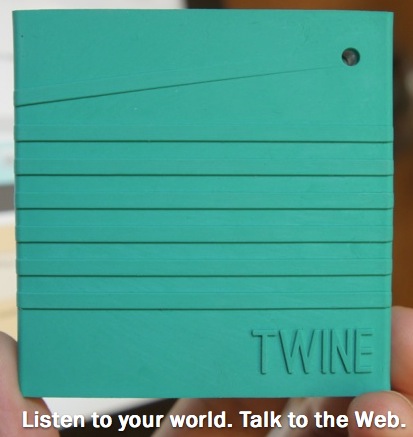So @xl_cr tweets,
Do you really believe the customer is in charge? If so check out @dsearls @vrm or visit ProjectVRM at http://projectvrm.org
#vrm
Since ProjectVRM.org is the shortcut to http://blogs.harvard.law.edu/vrm, that link goes here.
XL.CR is here. All the copy there says,
Ever upward.
Empowering buyers through invention.
“Webify your world with a Twine. http://t.co/cQxQLx7Z via @supermechanical— xl_cr
The shortlink goes to http://supermechanical.com/twine/. Twine is a gizmo that looks like this:
It’s funded through this Kickstarter effort by Supermechanical, which is comprised of David Carr and John Kestner, and HQ’d here in Cambridge, Mass, where I too am riding out The Storm.
Some copy:
How it works
Twine is a wireless sensor block tightly integrated with a cloud-based service. The durable, rubbery block has WiFi, on-board temperature and vibration sensors, and an expansion connector for other sensors. Power is supplied by micro USB or two AAA batteries (and Twine will email you when you need to change the batteries).The Spool web app makes it simple to set up and monitor your Twines from a browser anywhere. You set rules to trigger messages — no programming needed. The rules are put together with a palette of available conditions and actions, and read like English: WHEN moisture sensor gets wet THEN text “The basement is flooding!” We’ll get you started with a bunch of rule sets, and you can share rules you create with other Twine owners.
So I’m wanting to make a connection between all this good stuff and what’s going on with Phil Windley, Personal Clouds (for every item in the Internet of Things), The Live Web, Kynetx, KRL, Evented API’s, Sam Curren‘s SquareTag and the future I wrote about in The Wall Street Journal.
The VRM angle is distributed-everything, outside of silos, with individuals (which Craig Burton calls “enterprises of one”) in control.
Bonus links for Twine: The Wall Street Journal, Engadget, Wired, Forbes and Fast Company.


Leave a Reply